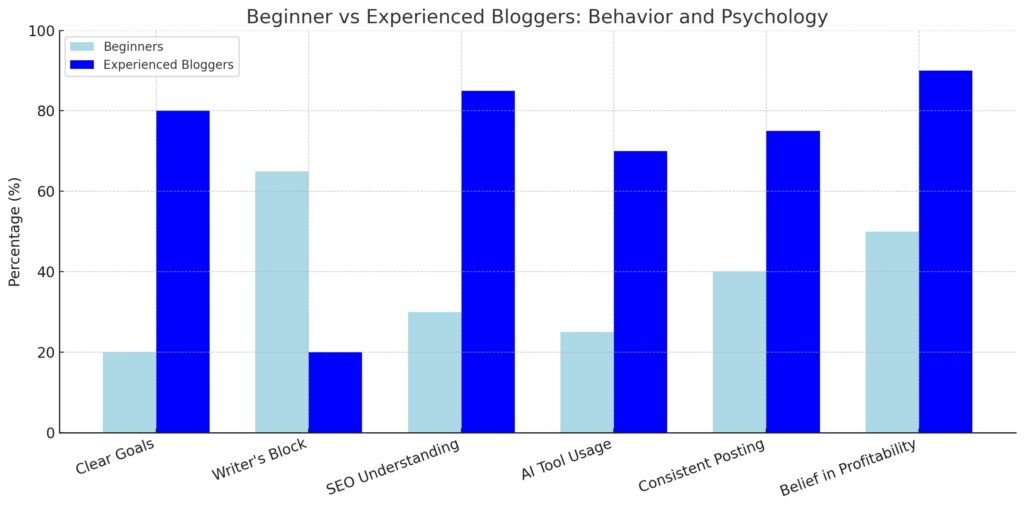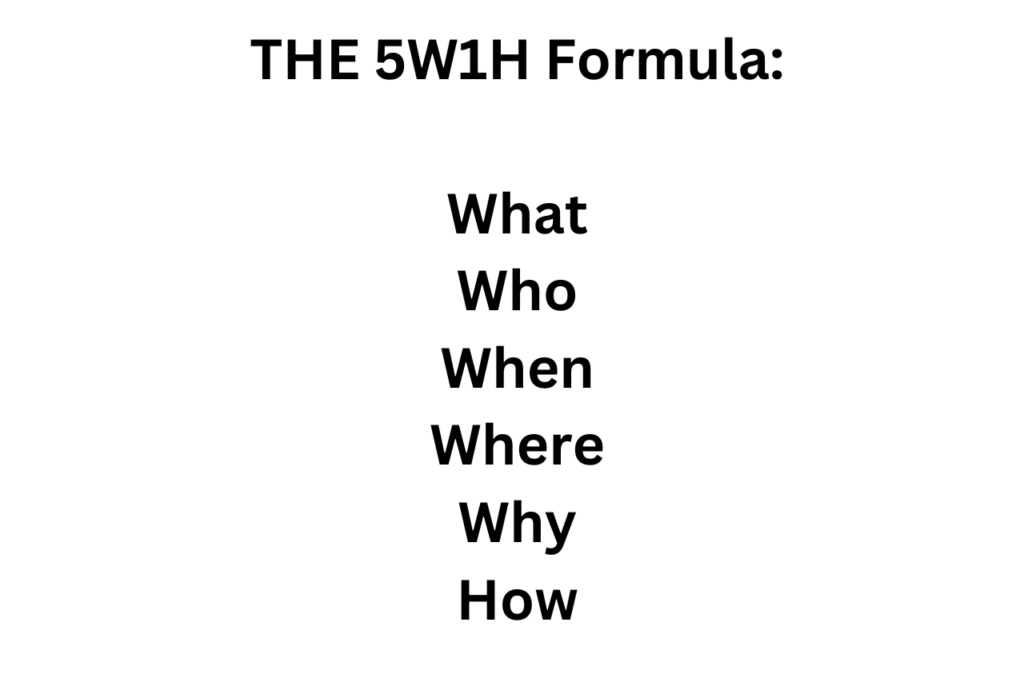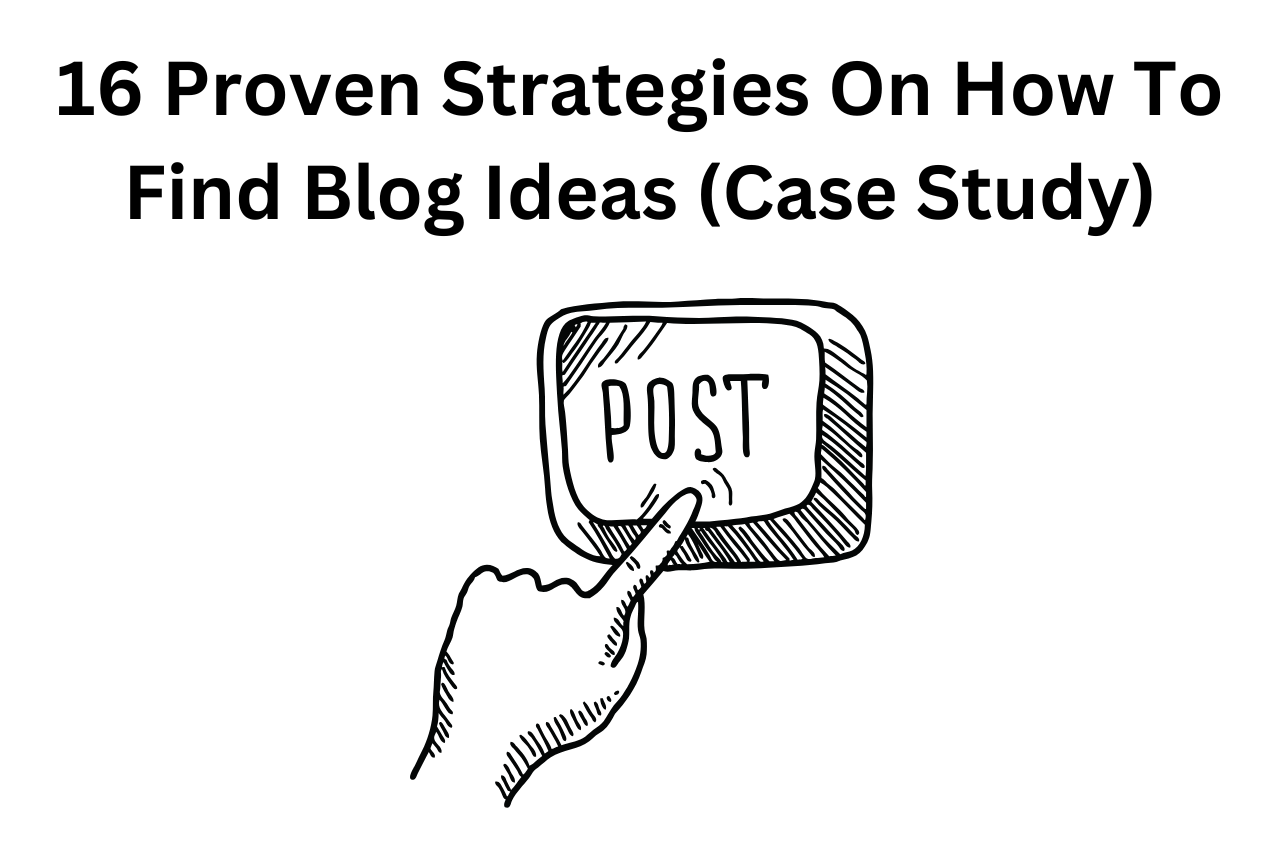Are you tired of staring at the blank screen and using keywords tools in the wrong way that limits your production? Do you still struggle to find best blog content ideas?
The reasons might shock you as a beginner and even an intermediate blogger. The results came out and they even shocked me.
Do you think multiple keyword research tools trigger your productivity? Yes its true and alarming but there are 16 strategies we discovered with 7 years of experience.
I was tired too, but after 7 years of blogging experience and launching multiple websites I tested and figured out these strategies before AI and after AI era and this case study proves the 16 strategies that worked supremely well and now I never face burnout to discover content again. 🙂
The real skill is not to write, but to find what to write and how to write strategically 🙂
Yes, even experienced blogger suffer to find innovative new ideas because they do the same thing over and over again.
Now, after lots of hits and trials, we discovered evergreen 16 proven strategies on how to find blog ideas, better content ideas and we’ll explain everything in a logical order covering Pre-AI and post-AI methods.
There are some bonus methods and tools too in the end 🙂
The 16 timeless strategies, tools and trends will help you understand how to boost your website credibility, and optimize your content for better SEO & GEO.
Key Takeaways From The Case Study Post:
- First 8 strategies are Pre-AI Era and last 8 are Post-AI Era and all are evergreen tested, and proven by time
- You never follow 5W1H Formula, Content Formula and avoid LTW Approach which are so beginner friendly and even experienced bloggers use them (everything mentioned in the first 8 steps)
- Beginners skip Traditional SEO, GEO, and omnichannel marketing that’s insanely important
- Most bloggers never run of ideas but they run out of systems that work
- Repurpose Content always outclasses someone who barely publishes anything else apart from a blog
- AI Tools are Idea Banks, while the AI prompts are currencies for the banks, use them wisely
- The psychological barrier of bloggers kill their website growth and traffic
- Always track your keywords from analytics and include semantic keywords
Here Is Our Featured Short Answer On How To Find Content Ideas:
In order to find blog content ideas, combine AI Tools research ability with keyword research tools, focus on audience search intent, understand user psychology, social trends and content gaps in your niche. Use proven methods like outreach, hidden secret formulas we shared for free, webinar results, SEO research, grabbing forum responses, infographic data, AI prompts, check Pinterest and related social media to generate unlimited blog post ideas in less time. Use Content Formula to discover new creative blog ideas.
I used these strategies and now I have 6+ months of content ideas ready already, it only took 10-30 minutes for me 🙂
I don’t have to worry till the Near Year Anymore 🙂 – My story on how I did this is down below.
Blog ideas can trigger your blog success, and choosing the right ideas and strategy can boost your production.
Table of Contents
Why This Case Study To Find Blog Content Ideas Matters?

As per our studies, we figured out the following psychological problems bloggers are facing:
- Before AI Era: How to find blog post ideas?
- After AI Era: There are too many ideas, tips & strategies? Everything is saturated! Which one actually works and matters?
- Pre-AI Era: The methods are classic, evergreen and powerful but under-utilized today, ignored and considered outdated by beginners
- Post AI-Era: AI-driven Prompts, tips quickly getting outdated, lack of knowledge about AI Tools, data-driven facts, figures and more opportunities, more gaps to cover using AI but no clarity
The problem is not the methods that you use, it is the psychology of bloggers, we think past is outdated, but its not, everything is driven by standard factors like SEO, Link building, backlinks, outreach, and more, its just that AI is evolving them even further but that doesn’t mean we can skip them for GEO, omnichannel marketing, right?
The Psychology Concept Of Beginner Bloggers vs Experienced Bloggers

Here are the psychological factors that makes a beginner and experienced blogger different as per our research:
| Behavior & Psychology | Beginner Bloggers Psychology (Why They Fail?) | Pro Bloggers Psychology (Why They Succeed) |
| Clear Goals | 80% Beginners never have clear goals | They have clear goals and missions |
| Writer’s Block | Most Beginners face writers blocks | With their expertise they overcome the writer’s block |
| SEO | Only 30% Beginner Bloggers understand basic SEO and implement them on their website | Pro bloggers have mastered the art of SEO, where beginners lack |
| AI Tools Usage | Only 25% hardly using AI Tools correctly | Pro bloggers leverage AI Tools and use to maximize their quality whereas beginners focus on quick gains |
| Consistency | 40% beginners try to stay consistent | Because of right consistency pro bloggers stay relevant in the industry |
| Believe In Profitability | Half of the beginners out in heir actual work as they believe blogging is still profitable | They earn multiple figures/month and know blogging is evolving |
16 Evergreen Strategies On How To Find Blog Ideas And Never Run Out Again
Over the years, blogging industry has evolved and I have discovered various key strategies out out which these 16 are proven and tested with time.
Some of the strategies are working since pre-AI ChatGPT era and some after arrival of AI and this has changed the game.
The problem is that with so many Keyword research tools, we often get stuck in the race to find the best ones, especially being a beginner its not good to pay 100$/month for these tools but is there any other free method that can help us to figure out a way of finding a blog idea that sustains for longer time?
There is also an urgent need to focus on the transformational content, needs and ideal interest of the audience that can help us to focus on content that’s helpful for them and its possible by leveraging resources and repurposing ideal content with effective time-management.
The first 8 are Pre-AI Era Strategies and last 8 are Post-AI Strategies.
Here are the 8 Pre-AI Era Strategies that are evergreen till date and works best for every blogger.
1. The 5W1H Evergreen Formula (Often Ignored)

This is an evergreen formula, and it starts with the 5WIH Procedure, where:
- 5W stands for What, Who, When, Where, Why
- 1H stands for How
In our academic studies we use this formula to understand concepts but for blogging we miss this, this if often causing you a lot of harm to find creative content ideas.
Well, a topic can have a direct message, but it can be transposed into multiple pieces of content with different search intent, purpose, and this approach is ignored by most beginners.
We think we can copy pro bloggers, but it’s not ideal. The thing is to find the loophole and understand “what is relevant for the audience rather than pleasing the algorithm”.
This shift in mindset can break your psychological barrier, and you will be able to apply the formula for your niche blogging.
How To Apply The 5W1H Formula In Your Blog Post?
To apply the 5W1H formula in your blog post, make sure you first break down your blog outline and content, then enter each section of the content on Google and analyze the top 10 articles, find out what people also ask questions, and ask questions related to 5W1H.
Identify the core elements in your topic, and analyze the angles of each section. Based on that, create a formula and cover as many questions as possible.
Example: If your blog topic is Digital Marketing, then the 5W1H Formula will be:
1. What is digital marketing?
2. Who can do digital marketing? Who is a digital marketer?
3. When does digital marketing benefit creators?
4. Where can we learn digital marketing?
5. Why is digital marketing important?
6. How does digital marketing support businesses?
This way, you can optimize your article for SEO, voice search, and you can get clicks, impressions, and more sales in the long run.
2. The Reverse Engineering Method

The Reverse engineering method simply starts by analyzing competitors, analyzing crucial patterns, and trying to create new content that is better and superior to the competitors.
The reverse engineering method allows us to unlock what’s working for them, what gaps are there, and how we can overcome the problems with our unique solutions.
For the reverse engineering method, focus on the following steps:
- First step is to identify your industry’s top content creators and break down their content, website by SEO Auditing, look at their Paid Ads, look at the content gaps and categories, and do a Google search for broad keywords and analyze where they rank, why they rank, and how much engagement they are getting on average.
- Secondly focus on analyzing their best blog post and the structure, breakdown what works, what grabs instant attention to you and for viewers, replicate ad improve it
- At last, track how often they post, and how they post, where they post, track what keywords they covered, are there some industry questions, and what are the unanswered questions that you can take advantage of? Check everything wisely, audit them entirely.
This is the most ignored method, trust me, and this is how we do, even I do reverse engineering, which is effective.
To check their SEO, make sure you ask ChatGPT about your competitors, and if it provides a lot of useful information, that means they are getting cited and are becoming popular in your niche.
3. Non AI-Data From Forums & QNA Sites

Yes, non-AI data from forum and QNA sites can dramatically boost your website growth and give lots of impressions and clicks.
Thousands and millions of questions are skeds every single day on these platforms, and many of them are unanswered or are long tail keywords, you can choose them and make a dedicated blog post on those topics.
This way you can get the trending ideas and thoughts of real people asking questions, and you can become an authoritative source in your niche.
How can you get more Long-Tail Keywords from Q&A sites?
Simply go to either Reddit or Quora, search your topic there, click on the questions, and see what’s the problem people are facing, then answer them in your blog in detail and share it in the Q&A site with your link. This way you can solve the pain points of the user and you will get loyal audience.
I tested it thoroughly over the years and it turned out to be valuable in multiple niches I worked like Technology, Sustainability, Climate change, Digital marketing, online business, luxury and more.
Q&A Sites and forums are goldmines for blogging and can escalate your blogging ideas, give you more creative ideas to experiment with, and you can see what works best for your website.
4. Traditional Books Structure Formula
Check traditional books and follow their structure.
For example: If you have a book on climate change, then check out what are the topics, sub-topics, and what is included in the table of contents or index page.
Check out what topics are being covered, how much detailed they are, and how you can cover them on your website and grow your website.
Important: We can apply the same formula by looking at the book, whether it’s fictional or non-fictional, academic books serve a great purpose for blogging and can help us find amazing blog ideas in no time.
But this is often ignored by us as we think we can get everything from the Internet, but after months, we realize we were wrong earlier.
You can better understand the structure once you create a silo-structure, don’t know how to make it? Well, learn by working on a profitable niche and creating sub-niches.
5. The Content Formula (No One Talks About)

A content formula is extremely hard to make, and we all need different formula since we all work on different websites, with different goals and ambitions, so how you can create your own content formula?
It’s simple, you need to follow the 4 steps below:
- First, analyze your natural way of writing, how you write, and see how you write. Do you first start with a hook, an intro, a question or something else? Do you include images more than 7? Do you write a conclusion, FAQs? First analyze your pattern.
- Second, analyze the trend in your niche, if people are adding multimedia in their blogs, do the same, if you witness podcast, do it
- Third, follow data, statistics from other blogs, and cite them effectively in your blog; this way, you can structure your blog
- Remember to check your competitors and see how they write, replicate with your USP, and this way you will be ahead in the competition.
This way you can develop a content formula that works best for you.
6. News + Trend Events Insights
Who doesn’t read news whether its offline or online? Nowadays most of us search for news online and while we read the headlines we discover interesting topics to write about for both local and global news.
News are great way to know what’s working in our industry, you can creative content ideas, and even trending events insights from a newspaper or search engines.
Check tools like Google Trends, exploding topics, etc., and you can get more ideas to brainstorm and add details to your blog post.
7. The Evergreen LTK For Beginners (Always Effective)

LTK stands for long-tail keywords and it means we must create content that’s long-term worth it and evergreen, so create detailed evergreen content that can rank for years to come and provide you with traffic and revenue consistently.
LTK also means long-tail words, and traditionally, they are easier to target, and you can find them using keyword research tools like Semrush, Ahrefs, Google, Keyword Planner, and more.
These keywords are generally 3-4+ words longer and cover instant pain points of the customers.
LTW keywords are always effective with high volumes and low competition and can serve a great purpose to help you secure top positions in search engines,
8. Audience Scanning & Idea Journal Segregation
Audience scanning was an amazing pre-AI formula to generate new ideas for your blog post. It is still effective today and provides a journal of ideas that you can check out.
If you are someone who still struggles with the questions like how to find content ideas or search it, it is better to first understand your audience and scan them.
Track your analytics for this and see who consumes your content and from which region, which country, are they males, females, their age?
Basically, a complete persona, and this way you can figure out who your audience is, why they are reading your blog, or why they are skipping, and how you can better attract them.
The next 8 steps are Post-AI arrival and today tips. tricks and strategies keeps on evolving but these 8 have stayed the same till now, they are evergreen in nature to generate and discover fresh new content ideas.
Now, The Post-AI Era Strategies
9. Use AI Tools As Thought Partners

Now that we have jumped to the Post-AI world strategies, start using AI tools as thought partners. Remember that AI tools are significantly important for brainstorming ideas, unique thoughts.
Put your thoughts in prompts, and AI can give you instant results. Ask AI to provide 5 semantic keywords related to your blog post, and it will provide you.
What are these keywords? Well, these are your LTW keywords and can help you to improve your SEO and better improve your overall blog post depth.
10. keyword Gap Tools
A keyword gap tool like Semrush can help you track which keywords you are still missing and you can add them in your website to rank for them. AI takes things to the next level.
You can even search for what gaps are present in your competitor’s website, analyze them, track them, and ask ChatGPT to give 10-20 awesome, interesting blog post ideas that you can use.
How does the Keyword Gap Tools Work?
The keyword gap tool helps you rectify which keywords we need to cover so users can find us, but in order to find such keywords, we need to follow keyword profiles, understand keyword overlap i.e. what keywords are missing in your websites but competitors are covering already, and at last focus on optimizing your existing content to rank better organically.
11. Use Google Trends + Exploding Topics
Yes, in AI World, the use of exploding topics, other similar AI tools, and Google Trends has increased significantly.
Copy the important keywords, paste them into Gemini or ChatGPT, and explore opportunities for more keywords that you can exploit.
12. The Zero-Click Questions

AI does not allow you to focus on traditional search engines anymore. In fact, almost most of the clicks are not coming from Google or search engines anymore.
Many people search on Google but never click on any answers anymore, so zero-click, in that case what’s the future of bloggers if they don’t get any click?
Well, the thing is everything is switched on to AI bots. People are asking questions as prompts and robots are answering by scraping Internet and ranking doesn’t matter for them, content format matters.
I told you previously that we all need different formats to succeed. Focus on developing one for yourself and answer questions as fast as possible in a structured way to get better rankings and get cited by AI.
13. AI-Prompt Engineering
Learn AI-prompt engineering since only giving basic prompts doesn’t help anymore; you need to understand how you give a functional prompt so that you can get a better output.
Mastering this, you can exploit weaknesses in your niche and gain an advantage using AI, but learning this takes practice and consistency.
14. Real Time Search Behavior
Learn, track real-time search behavior, checkout YouTube live, exploding topics, reddit latest questions to understand what users are demanding right now.
Also check out multiple social media platforms to figure out what works best for you, analyze the real-time data through comments and ask AI to craft a compelling answer.
15. Reaching Out To Startups
Yes, checkout startups, and see what are they doing, what are they covering, how they approach to solutions, learn, understand and apply them into your blog post.
This is time-consuming, but ask AI to reduce the manual work and exploit gaps, learn how they did it, and how you can do it even better.
16. GEO Optimization Criteria
Generative engine optimization is the modern-day SEO; it’s the same as SEO, but you will be cited by AI instead of Google searches, and focus on getting answered by ChatGPT and other engines so that you get more credibility and authority.
Grow your brand name online and win.
FAQs On How To Find Blog Ideas

How Many Blog Post Ideas Should 1 Have At Once?
You can have as many ideas as you want, but at least 10 ideas at once is a good start.
Can I Use AI To Find Blog Topics?
Yes, use AI to find blog topics, many professional bloggers do it including me.
Is It Okay To Copy Others Blog Ideas?
Yes, copy others’ blog ideas, but add your unique value proposition to make it even better.
How To Find Unlimited Content Ideas?
Ask AI to find unlimited content ideas, check out social media apps, comments, posts, Q&A sites, forums, latest Q&As, and answer all questions in multiple formats and win.
Conclusion On How To Find Blog Ideas
In order to find useful blog ideas, always focus on following the 16 strategies, analyzing competitors, trends, and focus on gaining authority-quality backlinks, improving GEO, and focusing on omnichannel marketing for optimum results. This, way you can generate better blog post ideas.
What’s Next For you?
All you have to do next is to focus on:
- Using the free keyword research tool I shared today
- Analyze the top 10 competitors and find what’s working for them, break the content into patches and expand further

With 7 years of blogging experience and I have worked on multiple niche and now I want to make sure I share what I learned over the years and master Digital Marketing and Blogging for the Future in this AI World.
I hold a masters degree in Climate sciences and policy and bachelors in Environmental Sciences and I’ll make sure you will get authentic, original, fresh, data-backed content.
I’ve dedicated myself to blogging with authenticity, honesty, transparency, depth, and purpose — not chasing trends, biasness or opinions, but sharing truth-based insights, timeless knowledge, and fact-rooted research that can empower lives across generations.
TimelessAim.com is not just a blog or a business.
It is the soul’s mission — to serve the world through truth, wisdom, honesty, right knowledge and educate people about the online world through latest digital marketing information.
Every single blog, article, tool, and project is built to share authentic, unfiltered real knowledge. Restore trust in information for all.
Building a legacy, an empire that starts with selfless truth and ends in global upliftment, helpful for everyone.
When information becomes sacred, the world totally transforms – Its True.
That’s the aim — and that’s the promise of TimelessAim 🙂


Very knowledgeable and interesting also
Thanks a lot 🙂 Hope This Helped.